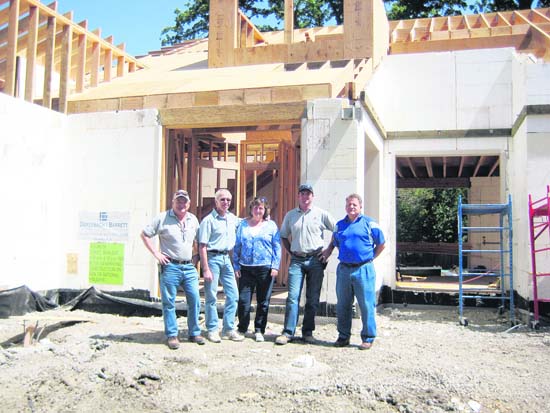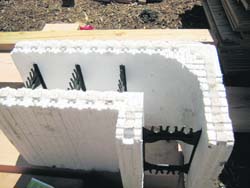| | Published April 29th, 2009
| What Are They Doing Here? A Story of Building Innovation in Lafayette
| | By Sophie Braccini |  | | Home built with ICFs in Lafayette; (left to right) Marty Diefenbach, Gary and Rica LaVerda (property owners), Jeff Barrett and John Campaglia (project manager with Diefenbach and Barrett) Photo Sophie Braccini
|
Rica and Gary LaVerda get it all the time, people walking the Moraga-Lafayette trail, passing their home and stopping to ask, "What are you guys doing here?" The home they are building does not look anything like the wood frame skeleton we're used to seeing. The white block structure has been drawing so much attention from passers-by that the LaVerdas have printed a flyer that explains why they're using ICFs to build their new home.
 ICFs are Insulated Concrete Forms. Imagine hollow polystyrene blocks, interlocking together like Lego pieces, reinforced with steel rebar and filled with concrete, and you'll have an idea of how to build an ICF wall. The technique was created in the 60's in Canada and has been used in the United States for about twenty years.
ICFs are Insulated Concrete Forms. Imagine hollow polystyrene blocks, interlocking together like Lego pieces, reinforced with steel rebar and filled with concrete, and you'll have an idea of how to build an ICF wall. The technique was created in the 60's in Canada and has been used in the United States for about twenty years.
 "We had been living in our Lafayette house for thirty years," explains Gary LaVerda, "and when we decided to rebuild it we met with Marty Diefenbach. He introduced us to the concept of ICFs." The LaVerdas were particularly impressed by the durability of the material, its thermal and acoustic insulation performance, and by its safety both from a fire and earthquake points of view.
"We had been living in our Lafayette house for thirty years," explains Gary LaVerda, "and when we decided to rebuild it we met with Marty Diefenbach. He introduced us to the concept of ICFs." The LaVerdas were particularly impressed by the durability of the material, its thermal and acoustic insulation performance, and by its safety both from a fire and earthquake points of view.
 "These homes made with ICFs are built to last 300 years," says Marty Diefenbach, partner in Diefenbach and Barrett, the contractor building the Lafayette home. "They are resistant to fire, don't attract termites, resist mold, provide superior sound insulation and keep the house cool or warm." The LaVerdas worked with EnergyWise, a consultant specialized in sizing and saving energy for family homes and as a result they ordered heating and cooling equipment sized for a 1200 square feet home, when theirs will be 2800 square feet.
"These homes made with ICFs are built to last 300 years," says Marty Diefenbach, partner in Diefenbach and Barrett, the contractor building the Lafayette home. "They are resistant to fire, don't attract termites, resist mold, provide superior sound insulation and keep the house cool or warm." The LaVerdas worked with EnergyWise, a consultant specialized in sizing and saving energy for family homes and as a result they ordered heating and cooling equipment sized for a 1200 square feet home, when theirs will be 2800 square feet.
 "The insulation rating of a home built with ICFs is R60, compared to a R13 for a wood home," claims Diefenbach. In fact the insulation is so good that a special automatic ventilation system has to be installed to make sure the house is properly ventilated.
"The insulation rating of a home built with ICFs is R60, compared to a R13 for a wood home," claims Diefenbach. In fact the insulation is so good that a special automatic ventilation system has to be installed to make sure the house is properly ventilated.
 "That may be one of the disadvantages of the ICFs," says Chris Avant, President of Canyon Construction, a local leader in sustainable construction, "you have to think carefully about your aeration because ICFs are so tight." Avant thinks that ICF is a good system, especially considering the energy gains over the operating life of the building. The drawback for him is the foam, a petroleum based product that surrounds the concrete.
"That may be one of the disadvantages of the ICFs," says Chris Avant, President of Canyon Construction, a local leader in sustainable construction, "you have to think carefully about your aeration because ICFs are so tight." Avant thinks that ICF is a good system, especially considering the energy gains over the operating life of the building. The drawback for him is the foam, a petroleum based product that surrounds the concrete.
 Concrete itself is a material that requires a lot of energy to manufacture. "We recommend the use of at least 30% fly ash in the concrete," says Bill Juhl, President for the Pacific Region of Amvic, the company that manufactures the ICFs, "70% in weight of the foam of our blocks is made of recycled material and the steel rebar is 100% recycled." Juhl said that in any green rating system ICF homes get points for thermal performance, ventilation, no emissions and use of local material (in the concrete).
Concrete itself is a material that requires a lot of energy to manufacture. "We recommend the use of at least 30% fly ash in the concrete," says Bill Juhl, President for the Pacific Region of Amvic, the company that manufactures the ICFs, "70% in weight of the foam of our blocks is made of recycled material and the steel rebar is 100% recycled." Juhl said that in any green rating system ICF homes get points for thermal performance, ventilation, no emissions and use of local material (in the concrete).
 Besides the thermal performance, what sold the LaVerdas is the safety aspect of this type of construction. "Both wood based homes and our ICF homes are engineered to maximize occupant safety in an earthquake," says Juhl, "a wood frame will twist and shake but shouldn't collapse. ICF frame doesn't twist; it rides the earthquake like a wave and won't collapse." According to Juhl, both types of homes are safe but the ICF ones won't require as much repair. With fire, he is even more convinced of the advantage of his product. "Our system helps with compliance to the new fire codes," he said, and added that when all the wooden homes burn down, the concrete homes remain standing.
Besides the thermal performance, what sold the LaVerdas is the safety aspect of this type of construction. "Both wood based homes and our ICF homes are engineered to maximize occupant safety in an earthquake," says Juhl, "a wood frame will twist and shake but shouldn't collapse. ICF frame doesn't twist; it rides the earthquake like a wave and won't collapse." According to Juhl, both types of homes are safe but the ICF ones won't require as much repair. With fire, he is even more convinced of the advantage of his product. "Our system helps with compliance to the new fire codes," he said, and added that when all the wooden homes burn down, the concrete homes remain standing.
 If you want to take a peek at the ICF blocks being installed in Lafayette, you'll have to hit the trail quickly. Once built and covered with whatever finish they choose the LaVerda's home will look like everyone else's. "We've chosen a craftsman style looking house that will be classic in looks but will incorporate 21st century technology," said the LaVerdas.
If you want to take a peek at the ICF blocks being installed in Lafayette, you'll have to hit the trail quickly. Once built and covered with whatever finish they choose the LaVerda's home will look like everyone else's. "We've chosen a craftsman style looking house that will be classic in looks but will incorporate 21st century technology," said the LaVerdas.

|
 | | | | | | | | Advertisement | | |
| | | | | | Comments | | | | | | | | | | | | | | | Subscribe / Unsubscribe | | | | | |
| | | | | |  | | |
| | |  | | |
| | | | | |

